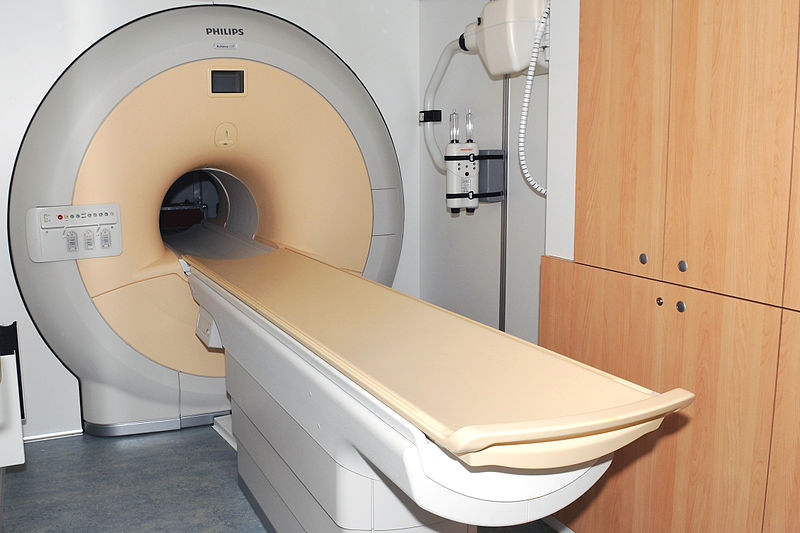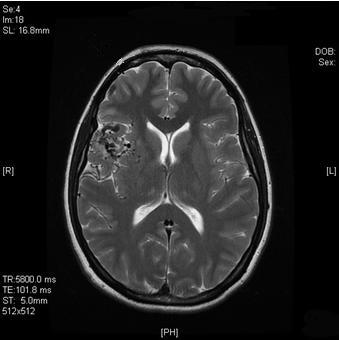This article explains the basics of how Magnetic Resonance Imaging works, its associated costs and precautions. It will be of particular interest to anyone suffering from claustrophobia who will be having an MRI scan.
Contents
- Introduction
- How does it work?
- What is it used for?
- Is it safe?
- Are there any other precautions?
- What are the main uses of MRI?
- Is MRI better than CT or Ultrasound?
- What about cost?
- Summary
Introduction
MRI (Magnetic Resonance Imaging) is a powerful imaging technique that is now widely available within the NHS and Private sector. In most conventional MRI scanners, the patient is examined lying down on their back, inside a fairly long narrow tunnel. There are some ‘open’ MRI scanners where the patient lies down on a more open couch. The image quality tends to be better using a conventional scanner, although modern technology has narrowed the gap.
How does it work?

It would take a large textbook of advanced physics to fully explain how MRI works, but in essence what happens is this: Surrounding the patient in the tunnel is a very powerful magnet. The magnetic field created makes the molecules inside the body ‘line-up’ like soldiers all facing in the same direction (like the needle of a compass does in the earth’s magnetic field). Next, a brief radio-signal is pulsed into the body, which twists the molecules at an angle, and which is then switched off. The molecules then turn back again to line up in the magnetic field, but different molecules from different tissues take slightly different lengths of time to ‘relax’ back in line, and it is this difference which is detected by the MRI scanner, and which produces the images.
What is it used for?
MRI can give unique anatomical and pathological information, which cannot be obtained in any other way. Other imaging techniques (such as CT scanning and Ultrasound) are complimentary to MRI, and are used in different clinical situations. MRI is particularly good at imaging the brain and spine, the joints and soft tissues of the body. MRI, (along with CT) is increasingly being used in scanning the abdomen and pelvis, but is not commonly used in the chest, where the CT scanner remains supreme.
Is MRI safe?
So long as certain safety precautions are taken before entering the magnetic field (see below) MRI is currently believed to be completely safe. Apart from some scanner noise, there is no sensation produced, and there are no after effects. MRI is avoided, if possible, in the first trimester of pregnancy, but this is simply as a precaution.
Are there any other precautions?
MRI uses a very powerful magnet to create images, and it is very important that metallic objects are not taken into the scanning room, either in, or on clothing, or in some cases where metal is lying within the body. Before anyone enters the scanning room, a long list of questions is always asked, and have to be very carefully answered. In particular it is important the anyone with a cardiac pacemaker, or anyone who has had a operation on their brain where clips have been used, does not enter the scanning room.
Claustrophobia: Up to 15% of the population are unable to tolerate conventional MRI, because of feelings of claustrophobia on entering the narrow tunnel, indeed, some people are unaware that they are claustrophobic until they enter the MRI tunnel for the first time. Some claustrophobic patients can be scanned with the help of some mild sedation, but for some, the only alternative is to use a so-called ‘open’ MRI scanner, which uses a different configuration to allow more space around the patient. The only truly open MRI scanner, however, is the Fonar Open Upright MRI, and the only place in the UK where this is currently available is in central London (www.uprightmri.co.uk). Upright MRI also allows patients to be scanned in specific positions, which is not possible with ‘conventional’ MRI.
What are the main uses of MRI?

- In the Brain: For the investigation of headaches, stroke, multiple sclerosis, dementia, cerebral infections and tumours.
- In the Spine: For the investigation of back pain, slipped discs, spinal infections and tumours.
- In the Joints: For internal derangements of the shoulder, knee, elbow, ankle, feet, wrist and hands.
- In the Soft Tissues: For the assessment of possible soft tissues abnormalities anywhere in the body.
- In the Abdomen: For the investigation of liver, biliary and pancreatic pathologies. Investigation of the small bowel, and pelvic pathologies, especially gynaecological abnormalities and diseases of the prostate.
- In the Vascular System: For the non-invasive investigation of circulatory abnormalities, including those of the head and neck, the kidneys, and the lower limbs.
These areas of investigation are by no means exclusive, MRI is a rapidly developing speciality in its own right, and many more applications are already in use, and many more will be developed in the near future.
Is MRI better than CT or Ultrasound?
No. These three imaging modalities (along with ‘plain’ radiographs and nuclear medicine) are all complementary to each other, and each have their own advantages and disadvantages. Together, they offer the referring clinician a powerful diagnostic set of tools.
What about cost?
MRI is very expensive technology. To install a modern MRI scanner will cost up to £1m. MRI scanners are also expensive to run, and require highly skilled operators to obtain images, and highly skilled radiologists to interpret them. These costs are reflected in scan pricing, which have deceased in recent years due to overprovision and market forces, but which still remain high. We can expect a further downward pressure on prices in the years to come.
Summary
MRI is a very powerful diagnostic tool which can frequently give diagnostic information unobtainable by any other means. So long as basic safety precautions are taken, it is entirely safe, and no ionising radiation is used. MRI scanners remain very expensive to install and run, and this is reflected in the costs of obtaining MR scans in the private sector.










